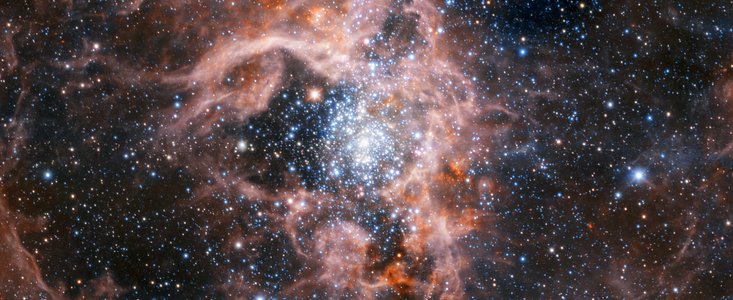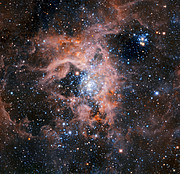Annuncio
Immagini più nitide per la camera infrarossa del VLT
L’impianto di ottica adattiva viene esteso allo strumento HAWK-I
30 Gennaio 2018
Il VLT (Very Large Telescope) dell’ESO ha ora un secondo strumento che lavora con il potente impianto di ottica adattiva (o AOF, dall’inglese Adaptive Optics Facility): lo strumento infrarosso HAWK-I (High Acuity Wide-field K-band Imager) [1], che sta beneficiando di immagini più nitide e tempi di esposizione più brevi. Ciò segue la riuscita integrazione dell’AOF con MUSE (Multi Unit Spectroscopic Explorer).
L’impianto di ottica adattiva è un progetto a lungo termine che sta per essere completato sul VLT (Very Large Telescope) dell’ESO. Fornisce correzioni per tutti gli strumenti montati su uno degli Unit Telescope del VLT (UT4, chiamato anche Yepun).
L’ottica adattiva compensa l'effetto di sfocatura dovuto all’atmosfera terrestre. Questo aggiornamento fa sì che HAWK-I possa ottenere immagini più nitide, necessitando di tempi di esposizione più brevi rispetto a prima per produrre risultati simili. Usando l’AOF, gli astronomi possono ottenere immagini di alta qualità con HAWK-I anche quando le condizioni climatiche non sono perfette.
Dopo una serie di test su questo nuovo sistema, gli astronomi e ingegneri del team responsabile della sua messa in funzione sono stati ricompensati con una serie di immagini spettacolari, inclusa una della Nebulosa Tarantola, la regione di formazione stellare nella Grande Nube di Magellano.
L’AOF, che ha reso possibili queste osservazioni, è composto da molte parti che lavorano insieme, tra cui il 4LGSF (sistema a quattro stelle guida laser) e lo specchio secondario deformabile e molto sottile di UT4 [2] [3]. Il sistema 4LGSF emette nel cielo raggi laser da 22 watt per far risplendere gli atomi di sodio nell’alta atmosfera, producendo punti di luce che imitano le stelle.
I sensori del modulo di ottica adattiva GRAAL (GRound layer Adaptive optics Assisted by Lasers) usano queste stelle guida artificiali per determinare le condizioni atmosferiche. Un migliaio di volte al secondo, il sistema AOF calcola la correzione che deve essere applicata allo specchio secondario deformabile del telescopio per compensare le perturbazioni atmosferiche.
GRAAL corregge le turbolenze nello strato dell’atmosfera fino a 500 metri al di sopra del telescopio, cioè nello strato più basso, vicino a terra. In base alle condizioni, le perturbazioni atmosferiche si manifestano a tutte le altitudini, ma alcuni studi hanno dimostrato che la maggior parte di esse si verifica nello strato inferiore.
Le correzioni applicate dall’AOF migliorano la qualità delle immagini in modo rapido e continuo, concentrando la luce per creare immagini più nitide. Rispetto a quanto fosse possibile prima, ciò permette a HAWK-I di risolvere dettagli più fini e di rilevare stelle più deboli.
MUSE e HAWK-I non sono gli unici strumenti che beneficeranno dell’AOF; in futuro, il nuovo strumento ERIS sarà installato sul VLT. L’AOF fa anche da apripista all’ottica adattiva sull’ELT (Extremely Large Telescope) dell’ESO.
Note
[1] HAWK-I è una camera ad ampio campo, uno strumento che fotografa il cielo nell’infrarosso. Può dunque vedere all’interno di polveri e gas interstellari che bloccano la luce ottica. Per ottenere un campo visivo così ampio, lo strumento usa quattro chip per l'acquisizione di immagini in maniera simultanea, catturando una grande quantità di informazioni.
[2] Con poco più di un metro di diametro, è il più grande specchio adattivo mai prodotto e ha richiesto una tecnologia all'avanguardia. È stato montato sull’UT4 nel 2016 (ann16078) per sostituire lo specchio secondario originale di tipo convenzionale.
[3] Sono stati sviluppati e sono ora operativi altri strumenti per ottimizzare le operazioni dell’AOF, tra cui un’estensione del software Astronomical Site Monitor, che monitora l’atmosfera per determinare l’altitudine a cui si manifesta la turbolenza, e il Sistema LTCS (dall’inglese Laser Traffic Control System), che impedisce agli altri telescopi di guardare direttamente i fasci laser o le stelle artificiali ed eventualmente rischiare di rovinare le proprie osservazioni.
Links
- Informazioni tecniche su GRAAL e sullo specchio secondario deformabile del VLT
- Evento celebrativo per la prima luce del sistema a quattro stelle guida laser sul VLT
- La camera HAWK-I
Contatti
Harald Kuntschner
ESO, AOF Project Scientist
Garching bei München, Germany
Tel: +49 89 3200 6465
Email: hkuntsch@eso.org
Richard Hook
ESO Public Information Officer
Garching bei München, Germany
Tel: +49 89 3200 6655
Cell: +49 151 1537 3591
Email: rhook@eso.org
Riguardo all'annuncio
| Identificazione: | ann18006 |



